Is there engine oil in the coolant reservoir of your vehicle? Is that bright green fluid turned to a milky color or brown? This may mean disastrous problems like head gasket failure, or be as harmless as an accidental spill during an oil change. Keep reading to learn what you should do if you spot oil in the antifreeze coolant reservoir.
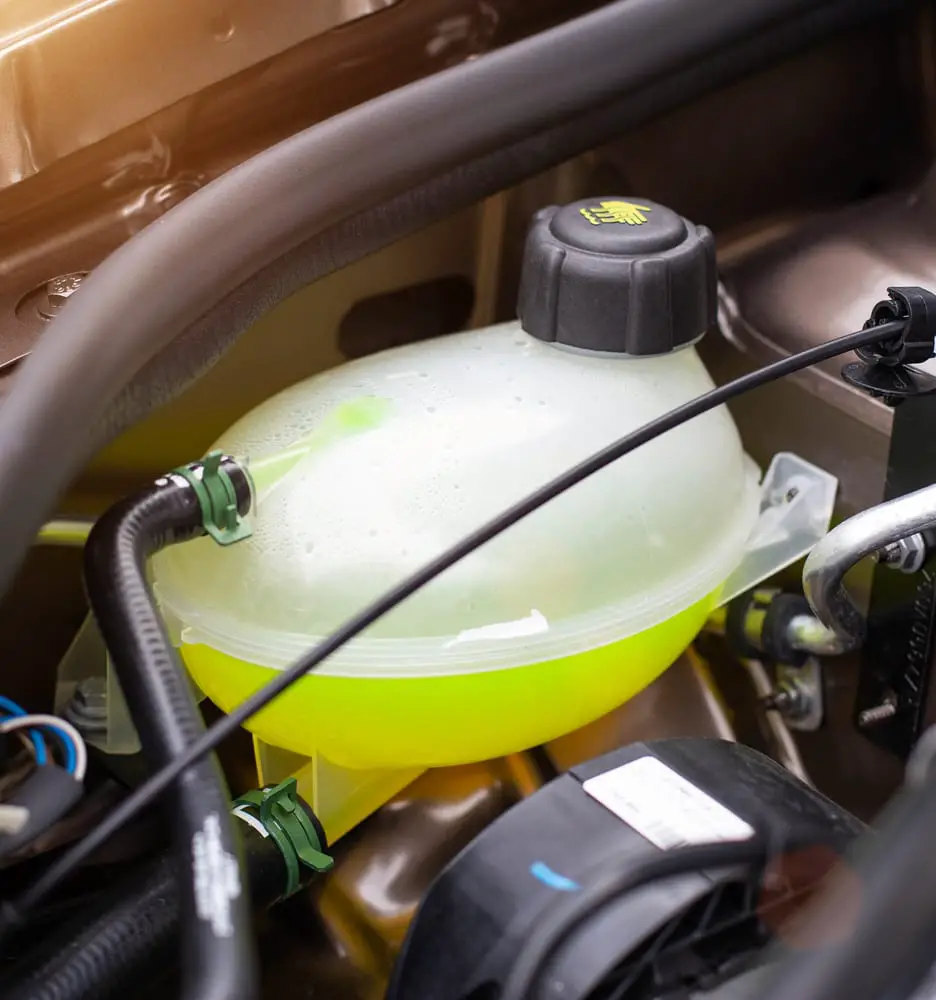
Introduction
Cars, trucks, and vans are essential parts of most peoples’ lives. When problems arise under the hood, they demand repair. Diagnosis and labor can be expensive, but an educated vehicle owner can often save money. With a willingness to learn, you can solve some issues without ever leaving your driveway.
Engine oil and coolant (antifreeze) are vital components of a vehicle. They serve different purposes, though, and should never meet. You wouldn’t want exhaust fumes mingling with your cabin air conditioning. In the same way, the lubrication and cooling systems of your car’s engine must remain separate. Sometimes, mechanical components can break down and allow oil and coolant to mix. If this happens to you, read on to discover what steps to take next.
What happens if there’s oil in engine coolant/antifreeze?
Motor (engine) oil is a dark, viscous liquid that lubricates engine components. Motor oil is designed to function at high temperatures and carries heat out of the engine.
Engine coolant (commonly called Antifreeze) contains water and a synthetic chemical called propylene glycol or ethylene glycol. The resulting liquid keeps your engine from getting too hot or too cold. Antifreeze/coolant is often bright green-yellow or orange in color.
As the old saying goes, oil and water don’t mix.
In the case of your car, motor oil and water-based coolant shouldn’t mingle either. If engine oil ends up in the coolant system, it can interfere with the proper operation of the radiator. Oil can degrade the rubber hoses that carry coolant through the engine. The presence of oil in your coolant (or vice versa) can hint at mechanical failures in the engine. If not repaired, these problems can cause the engine to overheat and stop working.
What does oil in the coolant look like?
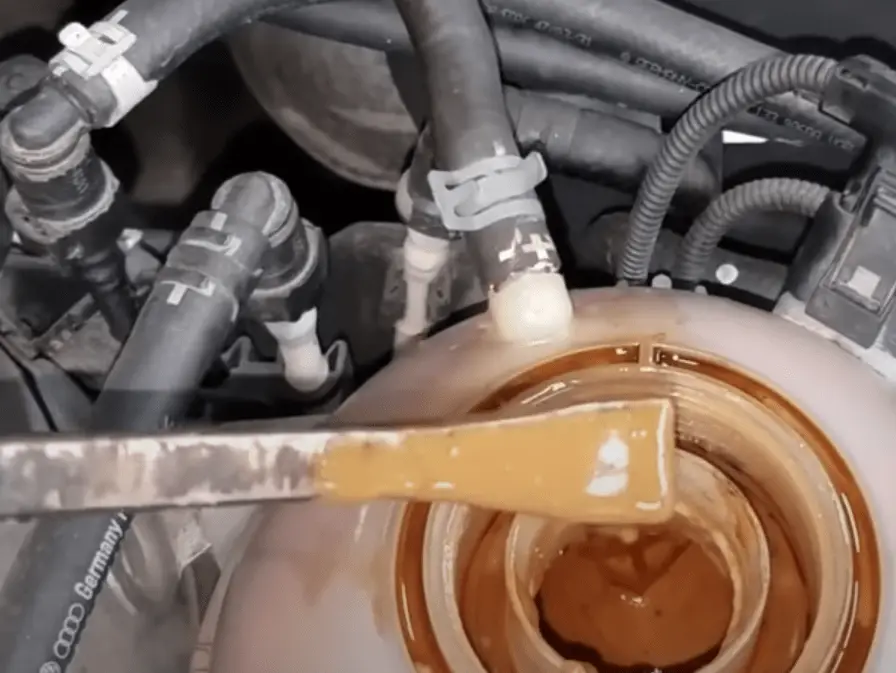
The Flat Rate Mechanic’s video below.
A quick look under the hood of your vehicle can reveal if there is oil in the coolant system. Open up the cap on the coolant reservoir. Coolant/antifreeze should appear to be a transparent, yellow-green, or orange color. Some vehicles may have different shades of coolant, but they should all be see-through, not dirty and muddy.
If you see a dark brown, thick liquid around the opening, that is likely motor oil. Small amounts of oil can also appear as dark spots in the coolant. Oil that has mixed with coolant can also appear thick and light brown. Some people think this mixture looks like mayonnaise or gravy. The mixed oil and coolant will be obvious to see at the top of the coolant overflow tank.
5 Causes of Oil in the Coolant Reservoir
If you find motor oil in your car’s coolant system, there are many potential reasons for the problem. Some of the causes are mechanical, while others are the result of operator error. All the issues are repairable if addressed quickly. If you ignore the problem, it may become dangerous to drive your car.
[su_panel background=”#ffff” shadow=”2px 2px 2px #eeeeee” radius=”4″]1. Blown Head Gasket
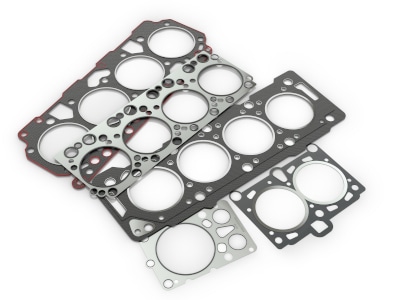
A head gasket is a vital component of any internal combustion engine. This metal seal separates the engine block from the cylinder head. It keeps the combustion chambers watertight by separating coolant fluid from the cylinders. The head gasket experiences extreme pressures and temperatures. Understandably, this component would sometimes fail. (Unless you drive a Subaru which has frequent head gasket problems)
When a head gasket develops a leak, people say that it is “blown” or broken.
These leaks allow coolant and oil to mix; the result can be motor oil in the coolant system. Oily coolant cannot regulate the engine’s temperature, which can lead to overheating. No one wants to find themselves stranded on the side of the highway with a smoking car engine. Read more about driving with a blown head gasket.
The precise design of a car’s engine allows it to perform well under ideal conditions. Any damage to components, such as the head gasket, can cause inefficient operation.
Need to fix a blown head gasket? Consider using a sealant to temporarily fix it until you can get it to the mechanic for a proper replacement.
[/su_panel] [su_panel background=”#ffff” shadow=”2px 2px 2px #eeeeee” radius=”4″]2. Cracked Cylinder Head
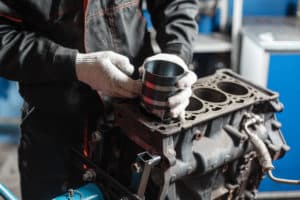
Like a leaky head gasket, a cracked cylinder head can permit oil and coolant to mix. A cracked head can create more severe problems, though. Cylinder heads are also more expensive to replace.
The cylinder head sits on the engine block and forms the top of the combustion chamber. These chambers are where the fuel mixes with air and gets ignited by the spark plug. The resulting combustion pushes the cylinders, turning the crankshaft and powering the vehicle.
Any engine part containing high-temperature explosions of compressed gases needs to be sturdy. An engine must also be as lightweight as possible. Automotive engineers design the cylinder head using aluminum for strength, yet lower weight.
The high pressure in the cylinders can cause cracks in the metal due to invisible weaknesses. A cracked head could also result in combustion problems and poor performance.
We wrote a cylinder head removal guide that you may be interested in reading if you want to tackle this project on your own.
[/su_panel] [su_panel background=”#ffff” shadow=”2px 2px 2px #eeeeee” radius=”4″]3. Failing Oil Cooler
The oil cooler on your vehicle works like a radiator, but for engine oil. Hot oil exchanges heat from the engine into the coolant system. The warm coolant then dissipates heat through the radiator into the air. These systems together help prevent a car or truck from overheating.
If the oil cooler is rusty, leaks can develop. These leaks can allow the engine oil to mix with the coolant. Seeing oil in the coolant reservoir can be a sign of this component failure. Without a working oil cooler, a vehicle will be at a higher risk of breaking down.
The good news is that an oil cooler rarely fails before other engine components. Even so, any mechanical part of the engine could break at any time. If you are noticing oil in your coolant, a failing oil cooler might be the culprit.
[/su_panel] [su_panel background=”#ffff” shadow=”2px 2px 2px #eeeeee” radius=”4″]4. Overfilled Fluids

Overfilling coolant can have negative impacts.
The coolant reservoir (or overflow tank) allows expansion space for the engine coolant as it heats up. If the fluid is full to the top, there is no room for expansion, and hot liquid can spill out. Animals and children may ingest the sweet-tasting, yet poisonous, chemical. In extreme cases, excess coolant can leak out. This can affect your car’s electrical components. Getting motor oil in your coolant system, is not a typical result of overfilling.
If you overfill motor oil in your car, there can be more significant problems. Increased oil pressure can cause gaskets to leak, which can result in oil and coolant mixing. Overfilling your vehicle’s oil can result in aeration, or getting air mixed into the oil. Motor oil with air bubbles in it does not lubricate as well and can lead to increased engine wear. Of course, spilled oil will also produce hazy smoke as it burns off the hot engine. If enough oil leaks to the outside of the engine, a fire could occur.
Adding too much coolant or oil to your car can create many issues. Unless other items fail, though, overfilling alone should not cause oil and coolant to mix.
[/su_panel] [su_panel background=”#ffff” shadow=”2px 2px 2px #eeeeee” radius=”4″]5. Operator Error
If you notice oil present in your coolant reservoir, the cause may not be mechanical. Human error may account for the problem.
Some people become confused with the various tanks under a car’s hood. There are separate fill caps for transmission fluid, brake fluid, and engine oil. Antifreeze/coolant and windshield washer fluid each have their reservoirs. A smart driver should check each of these fluids regularly and refill if needed.
If you do not use caution when topping off automotive fluids, you may add the wrong liquid to the tank.
When oil appears in your coolant reservoir, be sure that you (or someone else) has not made this mistake. If you realize this error, take immediate action to fix the problem before it becomes worse. Luckily, all you need to do is flush out the corrupted Antifreeze and replace it with fresh fluid.
While you’re inspecting, look for any coolant reservoir leaks and repair them before they get serious.
[/su_panel]Symptoms
[su_panel background=”#ffff” shadow=”2px 2px 2px #eeeeee” radius=”4″]1. Visual Inspection

Looking at your vehicle’s coolant is the best way to detect oil leaking into the reservoir. You should investigate further if you open the coolant tank and notice any of the following:
- Dark brown, thick liquid
- Creamy, light brown deposits (like gravy)
- Black or brown spots in the coolant
Engine coolant should appear clean and bright-colored, often either yellow-green or orange. If it does not look this way, your car may have a mechanical problem.
[/su_panel] [su_panel background=”#ffff” shadow=”2px 2px 2px #eeeeee” radius=”4″]2. Decreased Engine Performance
A crack in your engine can result in poor combustion. Oil in the coolant is not a cause of this problem, but rather a clue to search deeper. Cracks in the head gasket or cylinder head can allow coolant to enter the cylinders. The presence of coolant decreases the power of combustion and causes the vehicle not to run as it should.
[/su_panel] [su_panel background=”#ffff” shadow=”2px 2px 2px #eeeeee” radius=”4″]3. Drips or Leaks Under Your Vehicle
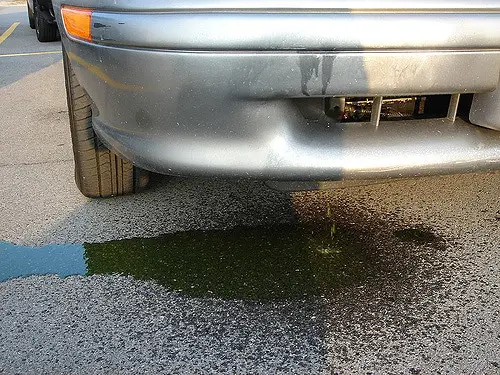
When you move your car from a parking space or driveway, look at the ground where you parked. If you see fresh puddles of liquid, take a closer examination. Oil or coolant drips under your vehicle suggest a leak in the mechanical system. You may have also been sloppy when refilling fluids.
[/su_panel] [su_panel background=”#ffff” shadow=”2px 2px 2px #eeeeee” radius=”4″]4. White or Blue Exhaust
Coolant leaks into the engine block can affect combustion. Igniting gasoline with water in it will cause steam or white smoke in the exhaust system. If the smoke looks blue, your engine may be burning oil leaked into the cylinders. In either situation, you should examine your engine for the source of the fluid leaks.
[/su_panel] [su_panel background=”#ffff” shadow=”2px 2px 2px #eeeeee” radius=”4″]5. High engine temperatures
Both motor oil and engine coolant serve to carry heat away from your vehicle’s engine. If leaks taint either of these fluids, they don’t work as well as they should. Oil in the coolant can clog cooling lines or make hoses brittle. This creates higher operating temperatures and makes the engine break down faster.
[/su_panel]
How to fix oil in the coolant reservoir
Once you discover oil in your coolant reservoir, figure out where the oil came from. Someone may have added oil to the coolant tank by mistake. If this is the case, remember that oil floats on water. Try to skim the oil out of the reservoir. Shop towels, a bulb syringe, or even a turkey baster are helpful tools for this project.
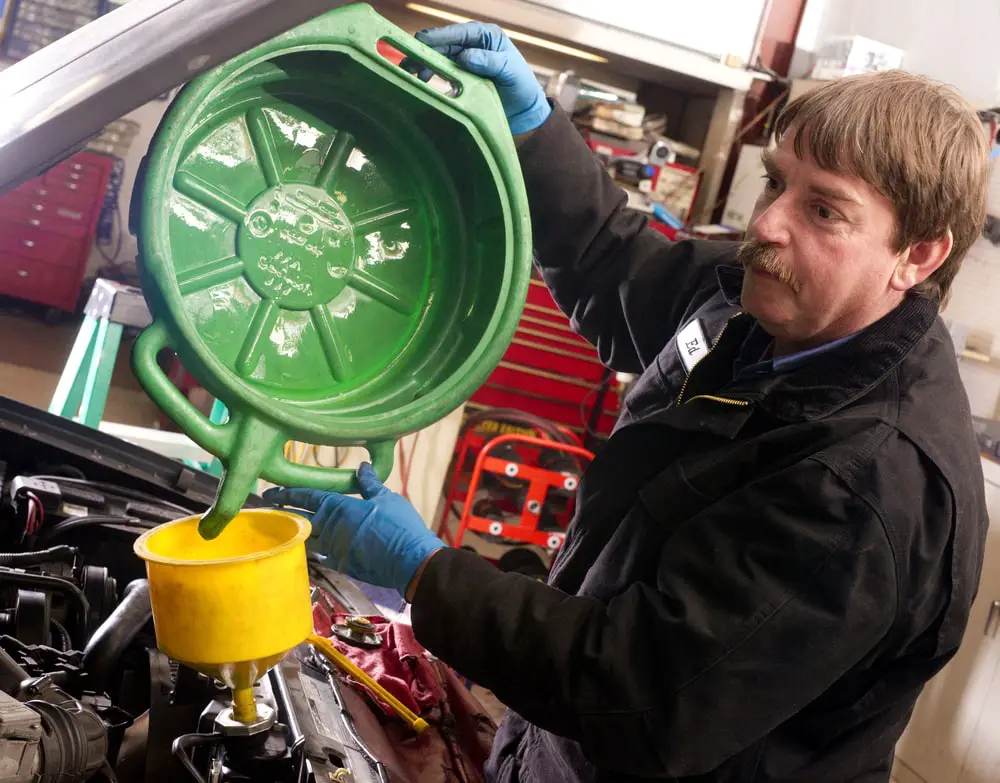
Next, you can disconnect the reservoir and remove it for cleaning. Be sure to catch any liquid that may run out of the hoses. Empty the coolant reservoir and wash it with dish soap to cut through the oily residue. Replace the coolant hoses if you think it necessary.
If the oil and coolant mix has gotten into the engine, consider a flush of the coolant system.
A DIY method is to add a small amount of detergent or dish soap to plain water in the coolant tank. Allow this mixture to circulate through the engine. The soap should remove any residual motor oil from the coolant system. You may need to repeat this at-home flush a few times until all traces of oil have disappeared. A professional coolant system flush with a trusted local mechanic may also be in order.
[su_panel background=”#ffff” shadow=”2px 2px 2px #eeeeee” radius=”4″]When It’s Not Your Fault
When you see oil in your coolant and know that it’s not the result of a mistake, further action needs to occur. As a temporary fix, you can buy a commercial additive for your engine. These sealants target the leaks and can buy you some time before scheduling repairs.
Even with the help of additives, you will want to pin down the source of the oil leak. You can investigate the issue yourself by testing the head gasket. Removal of the oil cooler for a closer look could guide you on how to proceed. Of course, the most effective but costliest option is to take your vehicle to a repair shop. The mechanics there will be able to tell you if you need to replace any engine parts.
[/su_panel] [su_panel background=”#ffff” shadow=”2px 2px 2px #eeeeee” radius=”4″]Repair Costs
The cost to cure oil in your car’s coolant varies based on location, the difficulty of the work, and parts. Repair costs will also depend on the specific diagnosis of your vehicle’s problem. Here’s a few sample costs (updated for 2023) depending on what the cause of the fluids mixing are:
- Coolant Flush = $65 (if done by yourself)
- Oil Cooler = $405
- Cylinder head replacement = $1,200+
- Head Gasket Replacement = $1,800+
A flush of the whole coolant system will cost about $65 if you do it yourself. A professional garage might charge two to four times that amount.
Replacement of the oil cooler can also be a DIY job. Depending on the model of your car, parts will run anywhere from $190 to $450. Having a mechanic perform the work could add $500 or more to the cost of the parts.
Cylinder head replacement involves significant disassembly of the engine. The model of a vehicle influences the repair cost. A Mercedes SLK will cost much more than a Honda Civic to replace parts. As a starting point, I’d plan on spending no less than $1,200 for cylinder head replacement.
Switching out the head gasket is a task best left to the professionals. Prices for the repair can vary from $1,400 to $2,200 or more. Since this tends to be a problem in older cars, the high cost of the fix may result in totaling out the value of the vehicle.
[/su_panel] [su_panel background=”#ffff” shadow=”2px 2px 2px #eeeeee” radius=”4″]Prevention
The best way to avoid expensive car or truck repairs is to make sure they are not needed in the first place. You can take steps now to prevent oil and antifreeze mixing and how to avoid coolant leaks and extend the working life of your vehicle.
- Pay attention when adding fluids to your car’s engine. Oil goes in the oil fill, while coolant goes in the overflow tank. The caps for all filling points show which fluid goes where. If you are not sure, take the time now to confirm before you create a problem. And be sure to replace all fill caps properly.
- Remember not to overfill any fluids. Motor oil, coolant, and other engine fluids need room to expand when they get hot.
- The use of a sealant additive ($10-$20) can help maintain gaskets and other engine seals in good condition.
- Listen for changes in the sound of the engine or sluggishness when driving. This could signal a cylinder leak or other combustion issue.
- Avoid overheating your engine. Keep an eye on the temperature gauge.
- If you see drips under your car, try to figure out what kind of fluid is leaking.
- Check your fluid levels often. Investigate any sudden changes.
You could also consider buying an electric car. There’s no oil to leak and no head gaskets or cylinders to break. Maintenance costs will be lower, and you’ll never need to stop at a gas pump again.
[/su_panel]Conclusion
Promptly addressing the issue of oil mixing with your antifreeze is essential in preventing further engine damage and costly repairs.
Discovering oil in coolant reservoir is a big deal, so don’t ignore it! Finding oil in your coolant tank can point to a significant repair, or it can remind you to be more cautious in the future. With the right information, you can be a more knowledgeable car owner. You might even save yourself a few hundred dollars in mechanic’s fees.